RFID and Mobile Fusion for Secure ATM Transaction Authentication
VerifiedAdded on 2020/03/01
|10
|1631
|33
Project
AI Summary
This project paper introduces an approach to enhance the privacy and security of ATM transactions using RFID and mobile fusion. It addresses the shift from traditional to digital marketing and the associated vulnerabilities in credit/debit card transactions. The primary objective is to develop a secure embedded system accessible only to authorized users through RFID and mobile technology. The research explores the background of the study, research aims and objectives, research questions, problem statement, and rationale. The literature review covers the application of RFID in various fields, emphasizing the importance of secure communication between servers and RFID tags. The methodology chapter outlines the research approach, data collection process, and ethical considerations. The project aims to analyze the working principle of RFID ATM cards, proposing a secure contactless credit card system and identifying the architecture of RFID for secure online transactions. The study also considers the limitations of the security authentication protocol and potential issues with transaction security.
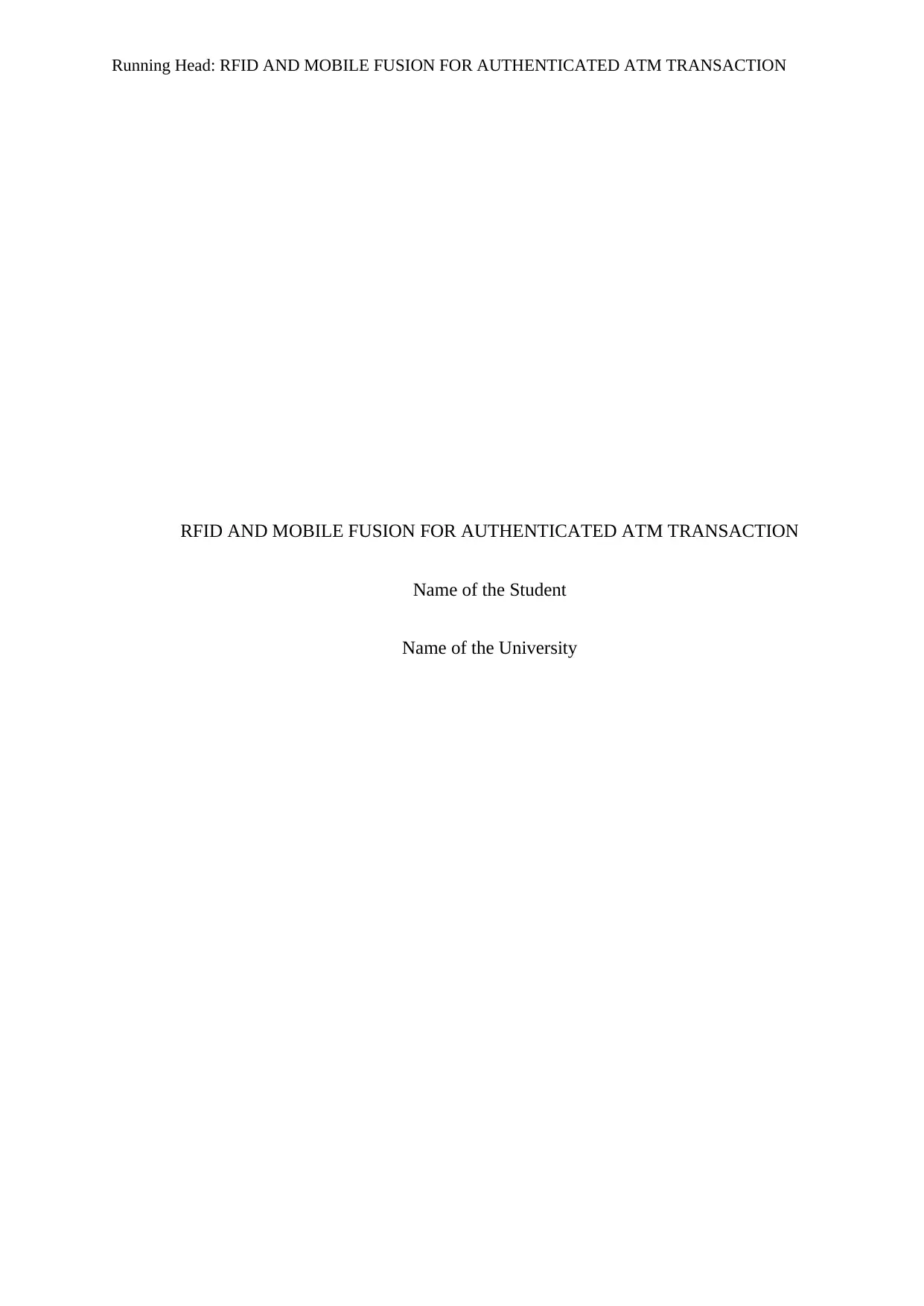
Running Head: RFID AND MOBILE FUSION FOR AUTHENTICATED ATM TRANSACTION
RFID AND MOBILE FUSION FOR AUTHENTICATED ATM TRANSACTION
Name of the Student
Name of the University
RFID AND MOBILE FUSION FOR AUTHENTICATED ATM TRANSACTION
Name of the Student
Name of the University
Paraphrase This Document
Need a fresh take? Get an instant paraphrase of this document with our AI Paraphraser
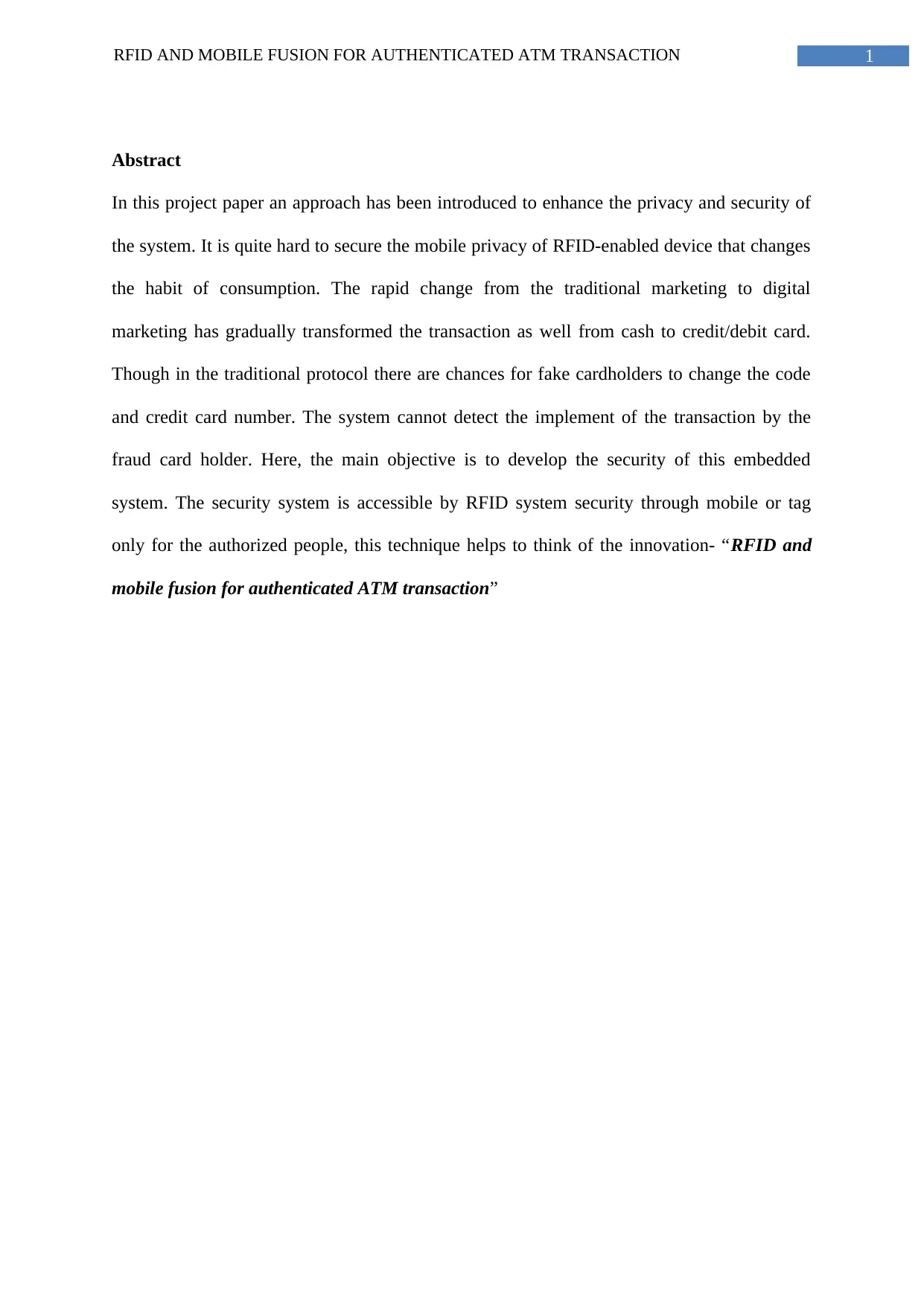
1RFID AND MOBILE FUSION FOR AUTHENTICATED ATM TRANSACTION
Abstract
In this project paper an approach has been introduced to enhance the privacy and security of
the system. It is quite hard to secure the mobile privacy of RFID-enabled device that changes
the habit of consumption. The rapid change from the traditional marketing to digital
marketing has gradually transformed the transaction as well from cash to credit/debit card.
Though in the traditional protocol there are chances for fake cardholders to change the code
and credit card number. The system cannot detect the implement of the transaction by the
fraud card holder. Here, the main objective is to develop the security of this embedded
system. The security system is accessible by RFID system security through mobile or tag
only for the authorized people, this technique helps to think of the innovation- “RFID and
mobile fusion for authenticated ATM transaction”
Abstract
In this project paper an approach has been introduced to enhance the privacy and security of
the system. It is quite hard to secure the mobile privacy of RFID-enabled device that changes
the habit of consumption. The rapid change from the traditional marketing to digital
marketing has gradually transformed the transaction as well from cash to credit/debit card.
Though in the traditional protocol there are chances for fake cardholders to change the code
and credit card number. The system cannot detect the implement of the transaction by the
fraud card holder. Here, the main objective is to develop the security of this embedded
system. The security system is accessible by RFID system security through mobile or tag
only for the authorized people, this technique helps to think of the innovation- “RFID and
mobile fusion for authenticated ATM transaction”
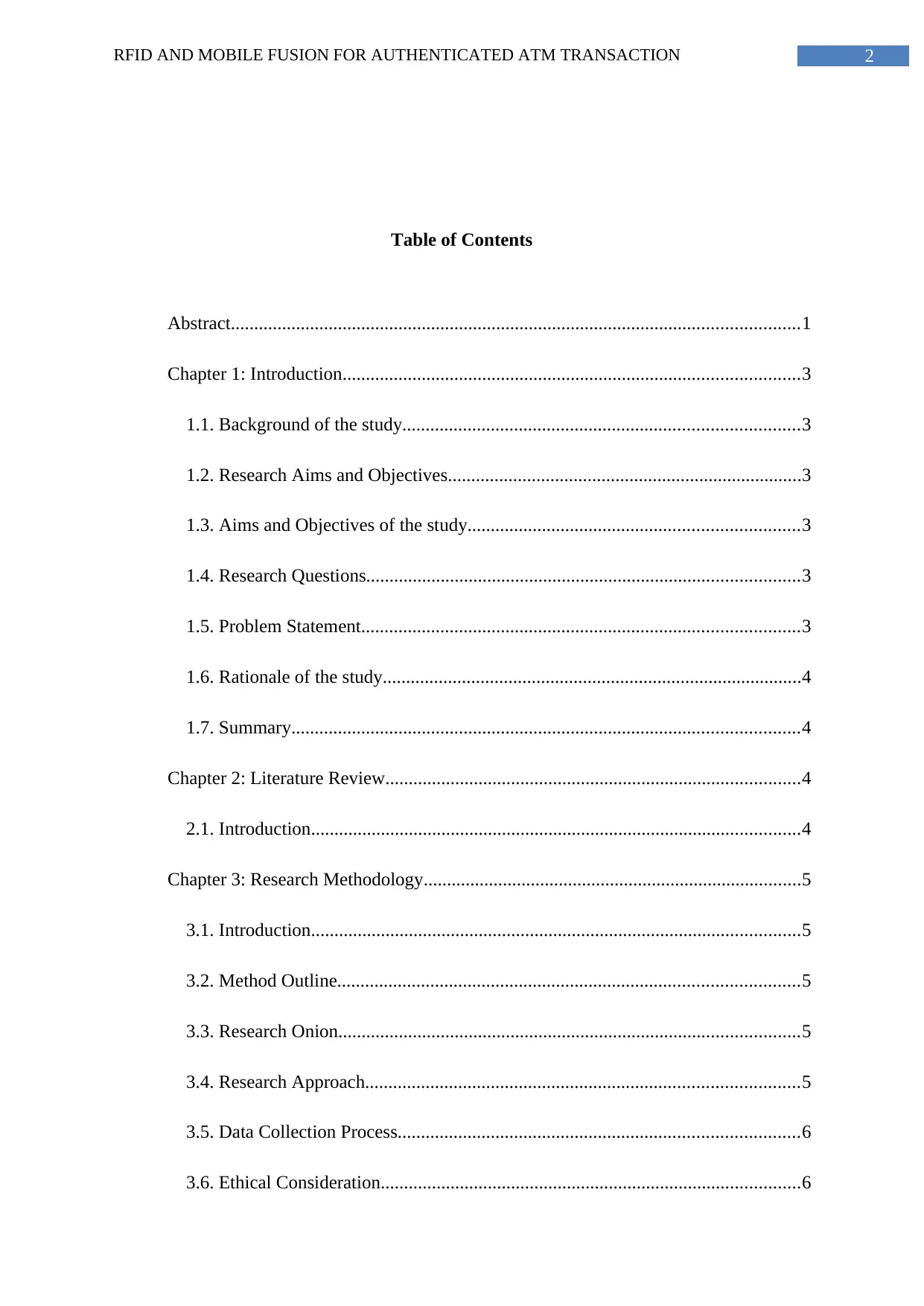
2RFID AND MOBILE FUSION FOR AUTHENTICATED ATM TRANSACTION
Table of Contents
Abstract..........................................................................................................................1
Chapter 1: Introduction..................................................................................................3
1.1. Background of the study.....................................................................................3
1.2. Research Aims and Objectives............................................................................3
1.3. Aims and Objectives of the study.......................................................................3
1.4. Research Questions.............................................................................................3
1.5. Problem Statement..............................................................................................3
1.6. Rationale of the study..........................................................................................4
1.7. Summary.............................................................................................................4
Chapter 2: Literature Review.........................................................................................4
2.1. Introduction.........................................................................................................4
Chapter 3: Research Methodology.................................................................................5
3.1. Introduction.........................................................................................................5
3.2. Method Outline...................................................................................................5
3.3. Research Onion...................................................................................................5
3.4. Research Approach.............................................................................................5
3.5. Data Collection Process......................................................................................6
3.6. Ethical Consideration..........................................................................................6
Table of Contents
Abstract..........................................................................................................................1
Chapter 1: Introduction..................................................................................................3
1.1. Background of the study.....................................................................................3
1.2. Research Aims and Objectives............................................................................3
1.3. Aims and Objectives of the study.......................................................................3
1.4. Research Questions.............................................................................................3
1.5. Problem Statement..............................................................................................3
1.6. Rationale of the study..........................................................................................4
1.7. Summary.............................................................................................................4
Chapter 2: Literature Review.........................................................................................4
2.1. Introduction.........................................................................................................4
Chapter 3: Research Methodology.................................................................................5
3.1. Introduction.........................................................................................................5
3.2. Method Outline...................................................................................................5
3.3. Research Onion...................................................................................................5
3.4. Research Approach.............................................................................................5
3.5. Data Collection Process......................................................................................6
3.6. Ethical Consideration..........................................................................................6
⊘ This is a preview!⊘
Do you want full access?
Subscribe today to unlock all pages.

Trusted by 1+ million students worldwide

3RFID AND MOBILE FUSION FOR AUTHENTICATED ATM TRANSACTION
3.7. Limitations of the study......................................................................................6
3.8. Summary.............................................................................................................6
Reference........................................................................................................................8
3.7. Limitations of the study......................................................................................6
3.8. Summary.............................................................................................................6
Reference........................................................................................................................8
Paraphrase This Document
Need a fresh take? Get an instant paraphrase of this document with our AI Paraphraser
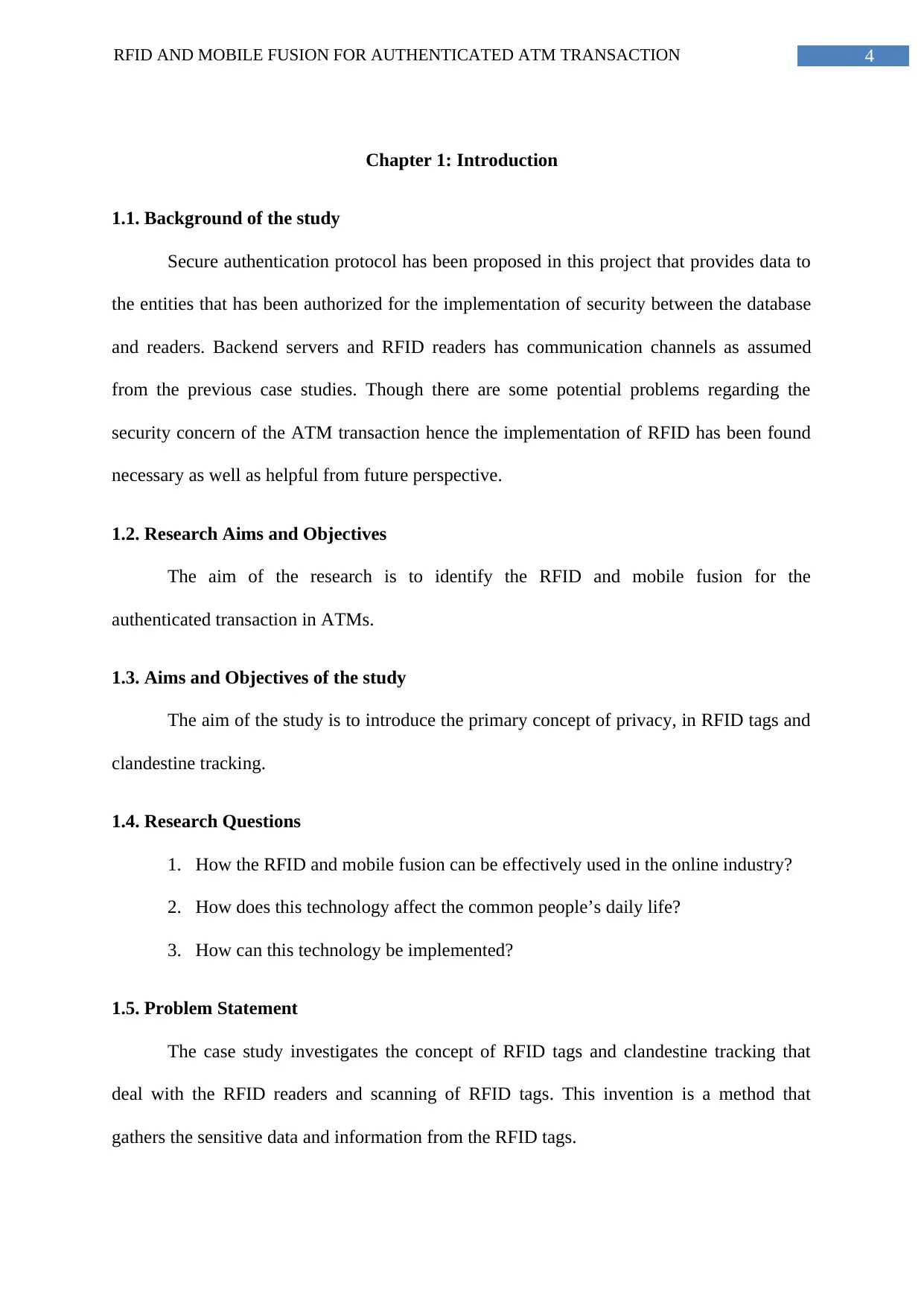
4RFID AND MOBILE FUSION FOR AUTHENTICATED ATM TRANSACTION
Chapter 1: Introduction
1.1. Background of the study
Secure authentication protocol has been proposed in this project that provides data to
the entities that has been authorized for the implementation of security between the database
and readers. Backend servers and RFID readers has communication channels as assumed
from the previous case studies. Though there are some potential problems regarding the
security concern of the ATM transaction hence the implementation of RFID has been found
necessary as well as helpful from future perspective.
1.2. Research Aims and Objectives
The aim of the research is to identify the RFID and mobile fusion for the
authenticated transaction in ATMs.
1.3. Aims and Objectives of the study
The aim of the study is to introduce the primary concept of privacy, in RFID tags and
clandestine tracking.
1.4. Research Questions
1. How the RFID and mobile fusion can be effectively used in the online industry?
2. How does this technology affect the common people’s daily life?
3. How can this technology be implemented?
1.5. Problem Statement
The case study investigates the concept of RFID tags and clandestine tracking that
deal with the RFID readers and scanning of RFID tags. This invention is a method that
gathers the sensitive data and information from the RFID tags.
Chapter 1: Introduction
1.1. Background of the study
Secure authentication protocol has been proposed in this project that provides data to
the entities that has been authorized for the implementation of security between the database
and readers. Backend servers and RFID readers has communication channels as assumed
from the previous case studies. Though there are some potential problems regarding the
security concern of the ATM transaction hence the implementation of RFID has been found
necessary as well as helpful from future perspective.
1.2. Research Aims and Objectives
The aim of the research is to identify the RFID and mobile fusion for the
authenticated transaction in ATMs.
1.3. Aims and Objectives of the study
The aim of the study is to introduce the primary concept of privacy, in RFID tags and
clandestine tracking.
1.4. Research Questions
1. How the RFID and mobile fusion can be effectively used in the online industry?
2. How does this technology affect the common people’s daily life?
3. How can this technology be implemented?
1.5. Problem Statement
The case study investigates the concept of RFID tags and clandestine tracking that
deal with the RFID readers and scanning of RFID tags. This invention is a method that
gathers the sensitive data and information from the RFID tags.
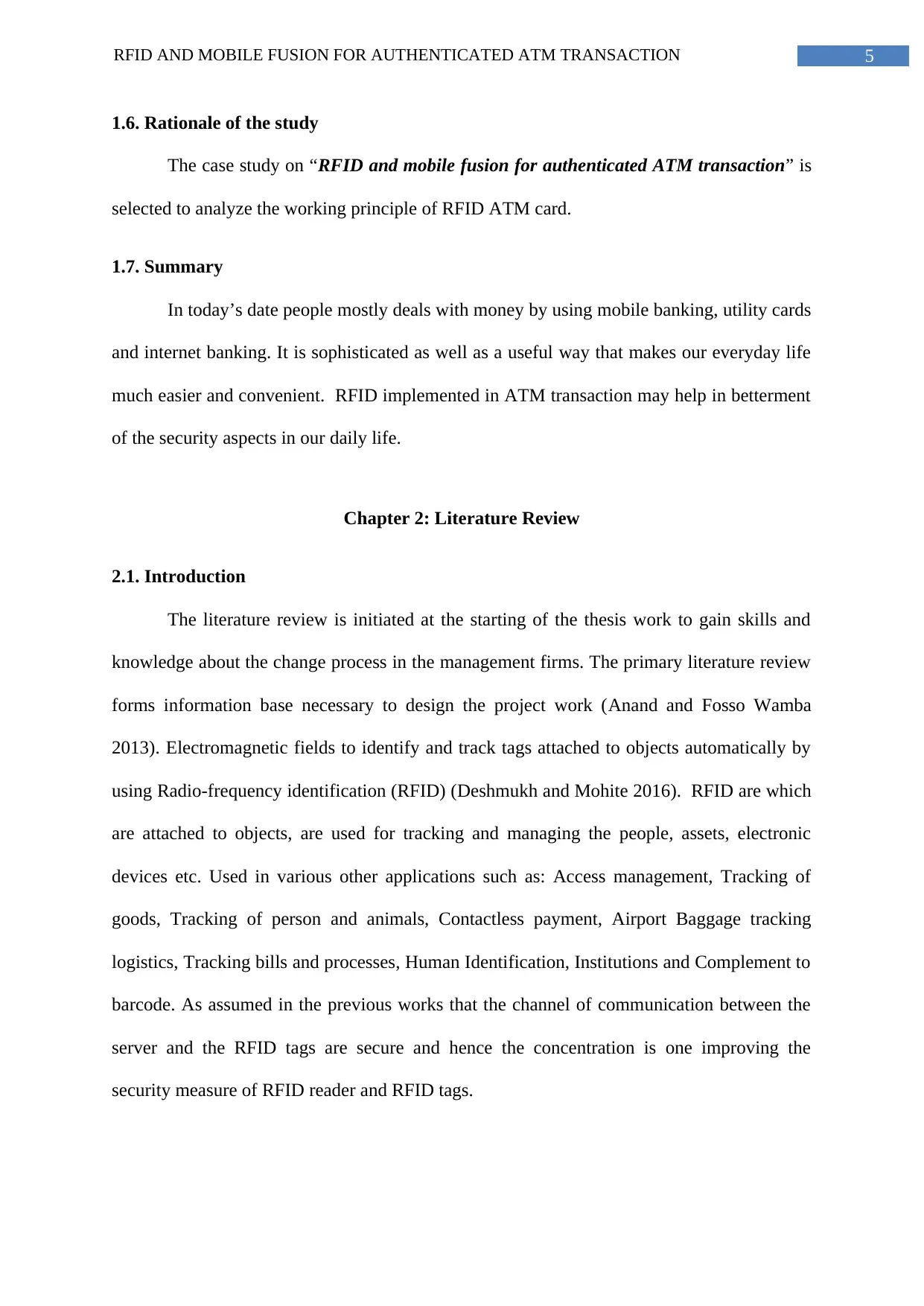
5RFID AND MOBILE FUSION FOR AUTHENTICATED ATM TRANSACTION
1.6. Rationale of the study
The case study on “RFID and mobile fusion for authenticated ATM transaction” is
selected to analyze the working principle of RFID ATM card.
1.7. Summary
In today’s date people mostly deals with money by using mobile banking, utility cards
and internet banking. It is sophisticated as well as a useful way that makes our everyday life
much easier and convenient. RFID implemented in ATM transaction may help in betterment
of the security aspects in our daily life.
Chapter 2: Literature Review
2.1. Introduction
The literature review is initiated at the starting of the thesis work to gain skills and
knowledge about the change process in the management firms. The primary literature review
forms information base necessary to design the project work (Anand and Fosso Wamba
2013). Electromagnetic fields to identify and track tags attached to objects automatically by
using Radio-frequency identification (RFID) (Deshmukh and Mohite 2016). RFID are which
are attached to objects, are used for tracking and managing the people, assets, electronic
devices etc. Used in various other applications such as: Access management, Tracking of
goods, Tracking of person and animals, Contactless payment, Airport Baggage tracking
logistics, Tracking bills and processes, Human Identification, Institutions and Complement to
barcode. As assumed in the previous works that the channel of communication between the
server and the RFID tags are secure and hence the concentration is one improving the
security measure of RFID reader and RFID tags.
1.6. Rationale of the study
The case study on “RFID and mobile fusion for authenticated ATM transaction” is
selected to analyze the working principle of RFID ATM card.
1.7. Summary
In today’s date people mostly deals with money by using mobile banking, utility cards
and internet banking. It is sophisticated as well as a useful way that makes our everyday life
much easier and convenient. RFID implemented in ATM transaction may help in betterment
of the security aspects in our daily life.
Chapter 2: Literature Review
2.1. Introduction
The literature review is initiated at the starting of the thesis work to gain skills and
knowledge about the change process in the management firms. The primary literature review
forms information base necessary to design the project work (Anand and Fosso Wamba
2013). Electromagnetic fields to identify and track tags attached to objects automatically by
using Radio-frequency identification (RFID) (Deshmukh and Mohite 2016). RFID are which
are attached to objects, are used for tracking and managing the people, assets, electronic
devices etc. Used in various other applications such as: Access management, Tracking of
goods, Tracking of person and animals, Contactless payment, Airport Baggage tracking
logistics, Tracking bills and processes, Human Identification, Institutions and Complement to
barcode. As assumed in the previous works that the channel of communication between the
server and the RFID tags are secure and hence the concentration is one improving the
security measure of RFID reader and RFID tags.
⊘ This is a preview!⊘
Do you want full access?
Subscribe today to unlock all pages.

Trusted by 1+ million students worldwide
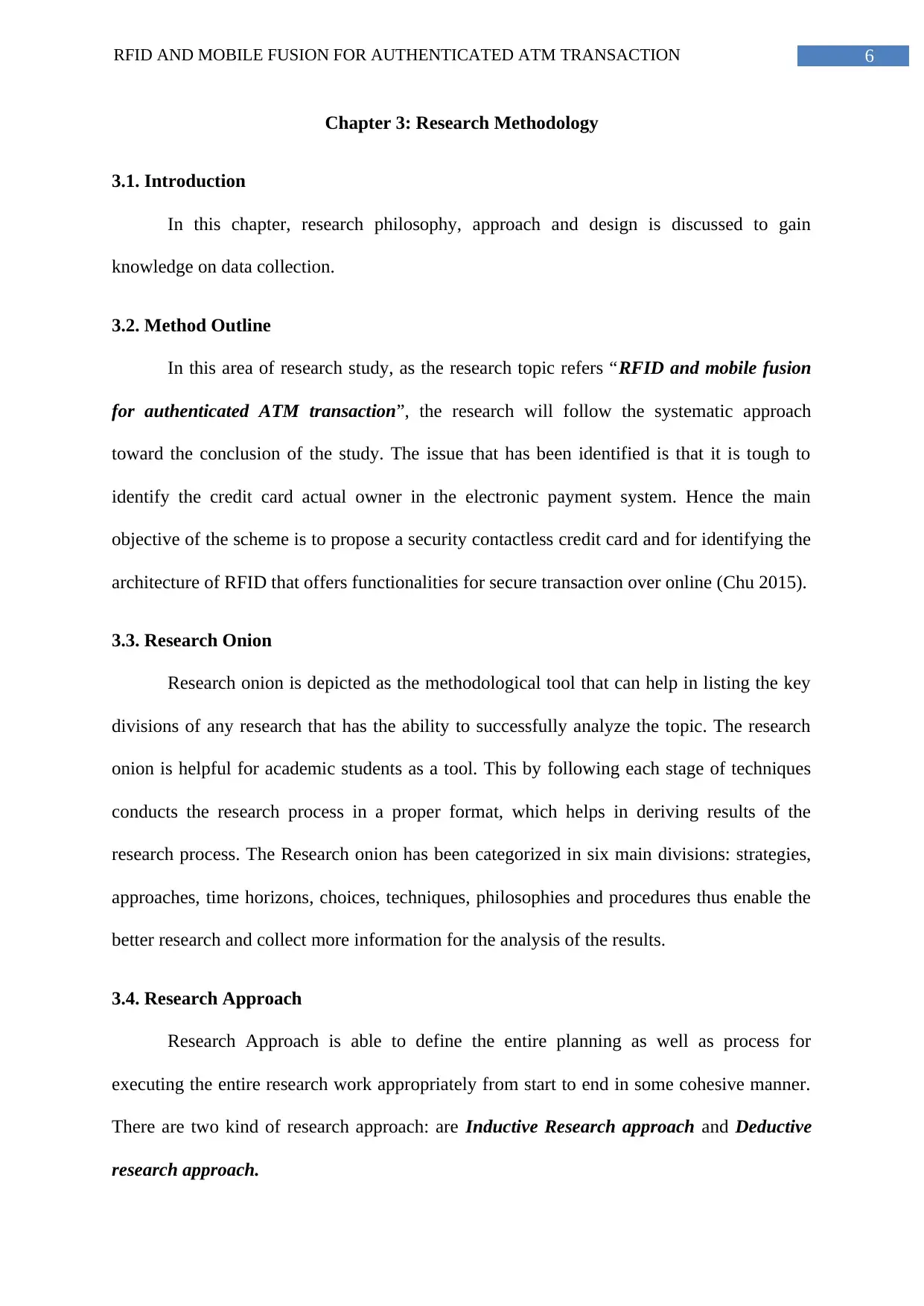
6RFID AND MOBILE FUSION FOR AUTHENTICATED ATM TRANSACTION
Chapter 3: Research Methodology
3.1. Introduction
In this chapter, research philosophy, approach and design is discussed to gain
knowledge on data collection.
3.2. Method Outline
In this area of research study, as the research topic refers “RFID and mobile fusion
for authenticated ATM transaction”, the research will follow the systematic approach
toward the conclusion of the study. The issue that has been identified is that it is tough to
identify the credit card actual owner in the electronic payment system. Hence the main
objective of the scheme is to propose a security contactless credit card and for identifying the
architecture of RFID that offers functionalities for secure transaction over online (Chu 2015).
3.3. Research Onion
Research onion is depicted as the methodological tool that can help in listing the key
divisions of any research that has the ability to successfully analyze the topic. The research
onion is helpful for academic students as a tool. This by following each stage of techniques
conducts the research process in a proper format, which helps in deriving results of the
research process. The Research onion has been categorized in six main divisions: strategies,
approaches, time horizons, choices, techniques, philosophies and procedures thus enable the
better research and collect more information for the analysis of the results.
3.4. Research Approach
Research Approach is able to define the entire planning as well as process for
executing the entire research work appropriately from start to end in some cohesive manner.
There are two kind of research approach: are Inductive Research approach and Deductive
research approach.
Chapter 3: Research Methodology
3.1. Introduction
In this chapter, research philosophy, approach and design is discussed to gain
knowledge on data collection.
3.2. Method Outline
In this area of research study, as the research topic refers “RFID and mobile fusion
for authenticated ATM transaction”, the research will follow the systematic approach
toward the conclusion of the study. The issue that has been identified is that it is tough to
identify the credit card actual owner in the electronic payment system. Hence the main
objective of the scheme is to propose a security contactless credit card and for identifying the
architecture of RFID that offers functionalities for secure transaction over online (Chu 2015).
3.3. Research Onion
Research onion is depicted as the methodological tool that can help in listing the key
divisions of any research that has the ability to successfully analyze the topic. The research
onion is helpful for academic students as a tool. This by following each stage of techniques
conducts the research process in a proper format, which helps in deriving results of the
research process. The Research onion has been categorized in six main divisions: strategies,
approaches, time horizons, choices, techniques, philosophies and procedures thus enable the
better research and collect more information for the analysis of the results.
3.4. Research Approach
Research Approach is able to define the entire planning as well as process for
executing the entire research work appropriately from start to end in some cohesive manner.
There are two kind of research approach: are Inductive Research approach and Deductive
research approach.
Paraphrase This Document
Need a fresh take? Get an instant paraphrase of this document with our AI Paraphraser
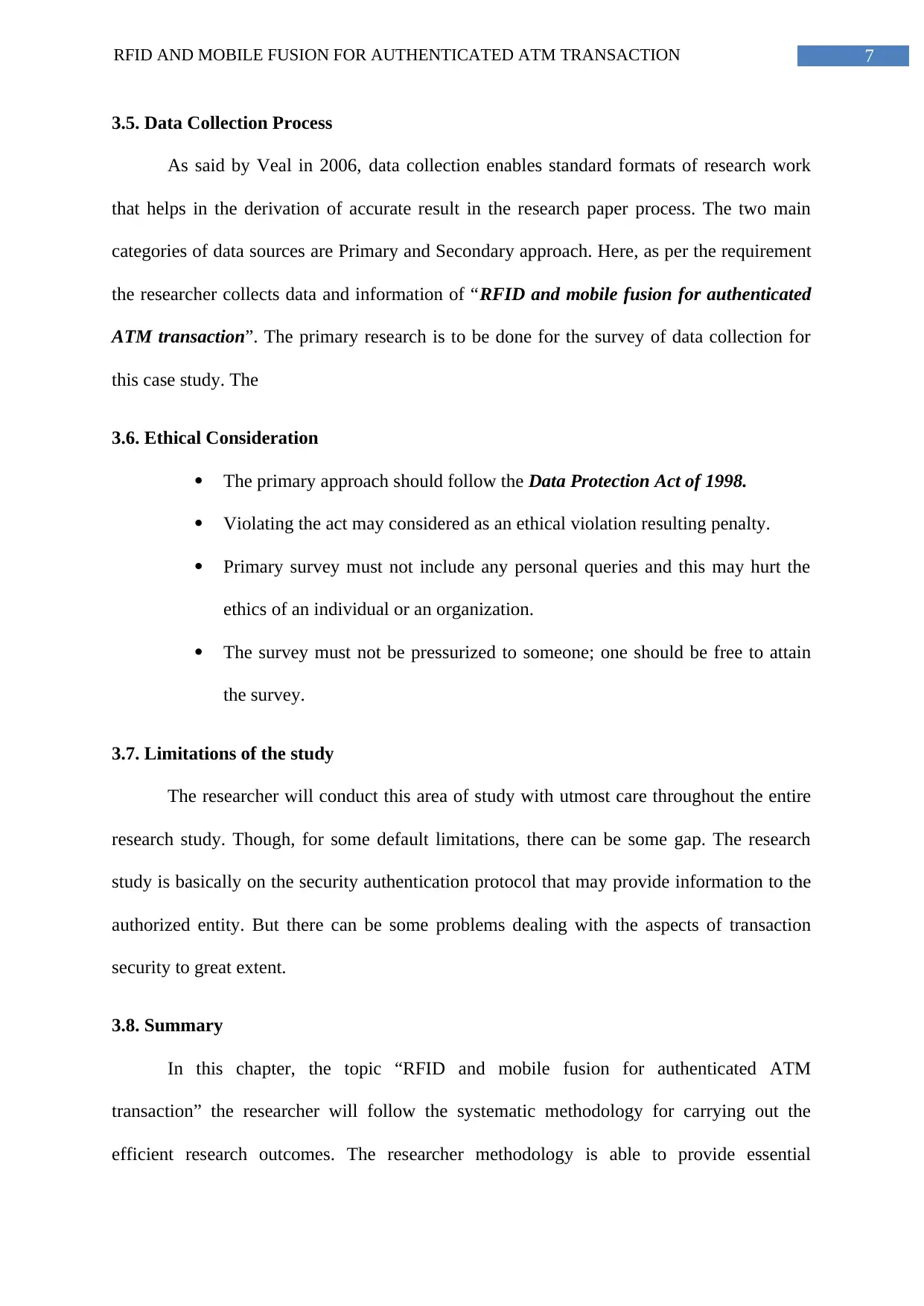
7RFID AND MOBILE FUSION FOR AUTHENTICATED ATM TRANSACTION
3.5. Data Collection Process
As said by Veal in 2006, data collection enables standard formats of research work
that helps in the derivation of accurate result in the research paper process. The two main
categories of data sources are Primary and Secondary approach. Here, as per the requirement
the researcher collects data and information of “RFID and mobile fusion for authenticated
ATM transaction”. The primary research is to be done for the survey of data collection for
this case study. The
3.6. Ethical Consideration
The primary approach should follow the Data Protection Act of 1998.
Violating the act may considered as an ethical violation resulting penalty.
Primary survey must not include any personal queries and this may hurt the
ethics of an individual or an organization.
The survey must not be pressurized to someone; one should be free to attain
the survey.
3.7. Limitations of the study
The researcher will conduct this area of study with utmost care throughout the entire
research study. Though, for some default limitations, there can be some gap. The research
study is basically on the security authentication protocol that may provide information to the
authorized entity. But there can be some problems dealing with the aspects of transaction
security to great extent.
3.8. Summary
In this chapter, the topic “RFID and mobile fusion for authenticated ATM
transaction” the researcher will follow the systematic methodology for carrying out the
efficient research outcomes. The researcher methodology is able to provide essential
3.5. Data Collection Process
As said by Veal in 2006, data collection enables standard formats of research work
that helps in the derivation of accurate result in the research paper process. The two main
categories of data sources are Primary and Secondary approach. Here, as per the requirement
the researcher collects data and information of “RFID and mobile fusion for authenticated
ATM transaction”. The primary research is to be done for the survey of data collection for
this case study. The
3.6. Ethical Consideration
The primary approach should follow the Data Protection Act of 1998.
Violating the act may considered as an ethical violation resulting penalty.
Primary survey must not include any personal queries and this may hurt the
ethics of an individual or an organization.
The survey must not be pressurized to someone; one should be free to attain
the survey.
3.7. Limitations of the study
The researcher will conduct this area of study with utmost care throughout the entire
research study. Though, for some default limitations, there can be some gap. The research
study is basically on the security authentication protocol that may provide information to the
authorized entity. But there can be some problems dealing with the aspects of transaction
security to great extent.
3.8. Summary
In this chapter, the topic “RFID and mobile fusion for authenticated ATM
transaction” the researcher will follow the systematic methodology for carrying out the
efficient research outcomes. The researcher methodology is able to provide essential

8RFID AND MOBILE FUSION FOR AUTHENTICATED ATM TRANSACTION
guideline to the research for completing the case study along with the research philosophy,
data sources, and research approach as well as research design.
guideline to the research for completing the case study along with the research philosophy,
data sources, and research approach as well as research design.
⊘ This is a preview!⊘
Do you want full access?
Subscribe today to unlock all pages.

Trusted by 1+ million students worldwide
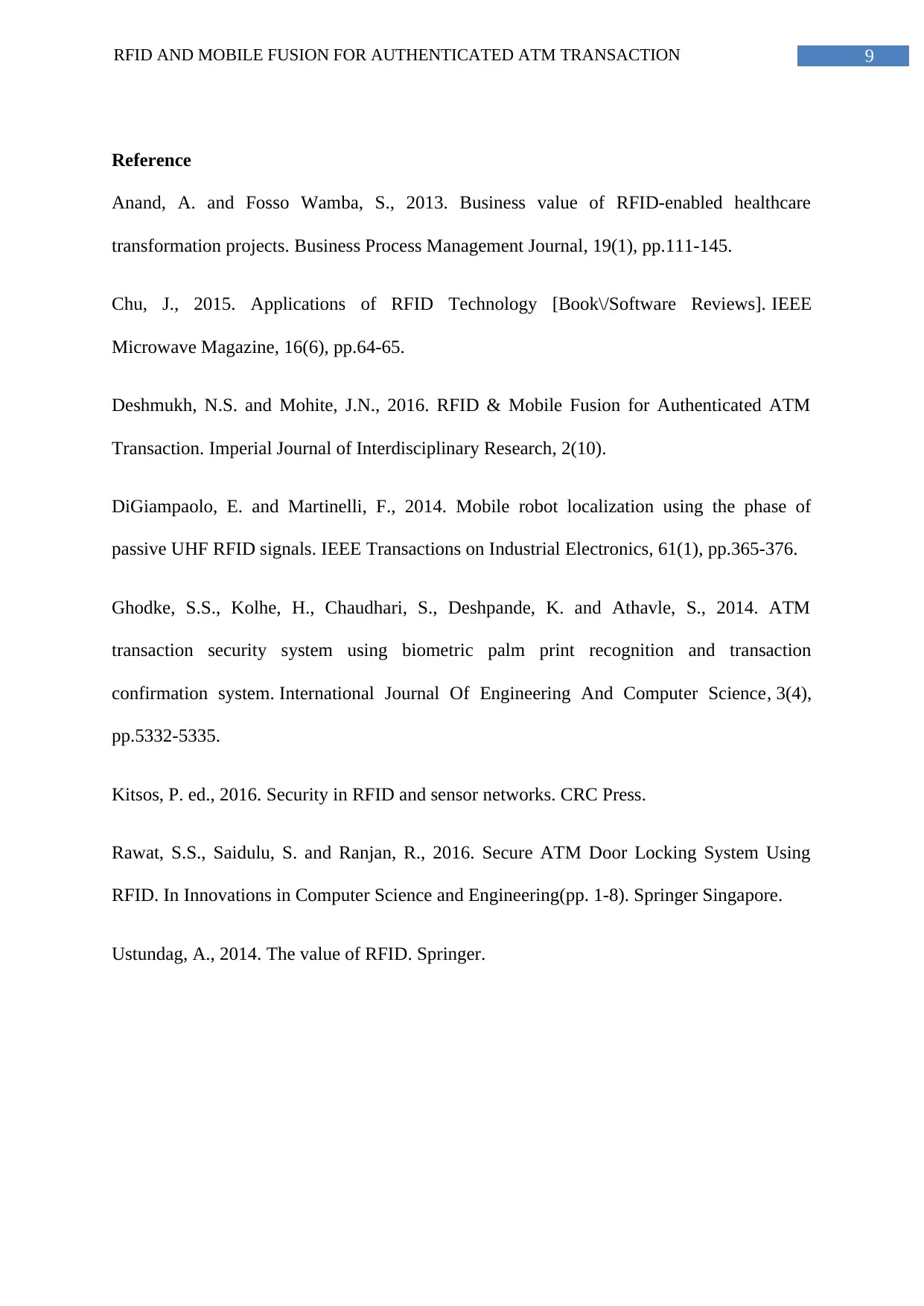
9RFID AND MOBILE FUSION FOR AUTHENTICATED ATM TRANSACTION
Reference
Anand, A. and Fosso Wamba, S., 2013. Business value of RFID-enabled healthcare
transformation projects. Business Process Management Journal, 19(1), pp.111-145.
Chu, J., 2015. Applications of RFID Technology [Book\/Software Reviews]. IEEE
Microwave Magazine, 16(6), pp.64-65.
Deshmukh, N.S. and Mohite, J.N., 2016. RFID & Mobile Fusion for Authenticated ATM
Transaction. Imperial Journal of Interdisciplinary Research, 2(10).
DiGiampaolo, E. and Martinelli, F., 2014. Mobile robot localization using the phase of
passive UHF RFID signals. IEEE Transactions on Industrial Electronics, 61(1), pp.365-376.
Ghodke, S.S., Kolhe, H., Chaudhari, S., Deshpande, K. and Athavle, S., 2014. ATM
transaction security system using biometric palm print recognition and transaction
confirmation system. International Journal Of Engineering And Computer Science, 3(4),
pp.5332-5335.
Kitsos, P. ed., 2016. Security in RFID and sensor networks. CRC Press.
Rawat, S.S., Saidulu, S. and Ranjan, R., 2016. Secure ATM Door Locking System Using
RFID. In Innovations in Computer Science and Engineering(pp. 1-8). Springer Singapore.
Ustundag, A., 2014. The value of RFID. Springer.
Reference
Anand, A. and Fosso Wamba, S., 2013. Business value of RFID-enabled healthcare
transformation projects. Business Process Management Journal, 19(1), pp.111-145.
Chu, J., 2015. Applications of RFID Technology [Book\/Software Reviews]. IEEE
Microwave Magazine, 16(6), pp.64-65.
Deshmukh, N.S. and Mohite, J.N., 2016. RFID & Mobile Fusion for Authenticated ATM
Transaction. Imperial Journal of Interdisciplinary Research, 2(10).
DiGiampaolo, E. and Martinelli, F., 2014. Mobile robot localization using the phase of
passive UHF RFID signals. IEEE Transactions on Industrial Electronics, 61(1), pp.365-376.
Ghodke, S.S., Kolhe, H., Chaudhari, S., Deshpande, K. and Athavle, S., 2014. ATM
transaction security system using biometric palm print recognition and transaction
confirmation system. International Journal Of Engineering And Computer Science, 3(4),
pp.5332-5335.
Kitsos, P. ed., 2016. Security in RFID and sensor networks. CRC Press.
Rawat, S.S., Saidulu, S. and Ranjan, R., 2016. Secure ATM Door Locking System Using
RFID. In Innovations in Computer Science and Engineering(pp. 1-8). Springer Singapore.
Ustundag, A., 2014. The value of RFID. Springer.
1 out of 10
Related Documents
Your All-in-One AI-Powered Toolkit for Academic Success.
+13062052269
info@desklib.com
Available 24*7 on WhatsApp / Email
![[object Object]](/_next/static/media/star-bottom.7253800d.svg)
Unlock your academic potential
Copyright © 2020–2025 A2Z Services. All Rights Reserved. Developed and managed by ZUCOL.




